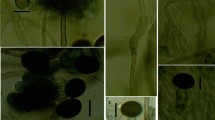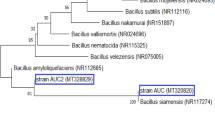Abstract
To explore the role of endophytic bacteria from a medicinal plant in the production of bioactive compounds, bacterial strains (10 different taxa) were isolated from the surface sterilized stem of healthy Ephedra foliata. The endophytes were related to Firmicutes, Actinobacteria and Proteobacteria. They were identified as members of Bacillus (5 strains), Paenibacillus (2 strains), Brevundimonas (1 strain), Kytococcus (1 strain), and Microbacterium (1 strain). The bacterial metabolites were extracted by chloroform and examined for antimicrobial, antioxidant and anticancer properties. Strain F5 (Paenibacillus) showed moderate antibacterial activity against Staphylococcus aureus, Bacillus subtilis, Pseudomonas aeruginosa, and Escherichia coli. Its antibacterial activity was enhanced 2.3 times in the optimum conditions (starch 1% w/v, malt extract 0.2% w/v, pH 7, temperature 30 °C, inoculum size 3% v/v, and 48 h incubation time, at the basal tryptic soy broth medium). The highest DPPH scavenging capacity (EC50 at 43.0 µg/ml) was observed by the extract of the strain A1 (Microbacterium). The highest cytotoxic activity on HeLa cancerous cell was related to the extract obtain from strain A3 (Kytococcus) and its IC50 values were determined as (µg/ml) 104, 64, and 43 after 24, 48, and 72 h, respectively. Chemical identification of the extracts by tandem mass spectrometry revealed possible presence of alkaloid, aminoglycoside, flavonoid, and terpenoid compounds as previously extracted from other medicinal plants. Our results show the great potential of these endophytes for production of plant-related bioactive compounds.





Similar content being viewed by others
References
Abourashed EA, El-Alfy AT, Khan IA, Walker L (2003) Ephedra in perspective–a current review. Phyto Res 17:703–712
Akinsanya MA, Goh JK, Lim SP, Ting ASY (2015) Diversity, antimicrobial and antioxidant activities of culturable bacterial endophyte communities in Aloe vera. FEMS Microbiol Lett 362:184
Blois MS (1958) Antioxidant determinations by the use of a stable free radical. Nature 26:1199–1200
Chowdhury MEK, Jeon J, Rim SO, Park YH, Lee SK, Bae H (2017) Composition, diversity and bioactivity of culturable bacterial endophytes in mountain-cultivated ginseng in Korea. Sci Rep 7:1–10
Cory H, Passarelli S, Szeto J, Tamez M, Mattei J (2018) The role of polyphenols in human health and food systems: a mini-review. Front Nutr 5:1–9
Demirgan R, Karagöz A, Pekmez M, Önay-Uçar E, Artun FT, Gürer Ç, Mat A (2016) In vitro anticancer activity and cytotoxicity of some papaver alkaloids on cancer and normal cell lines. Afr J Tradit Complement Alt Med 13:22–26
Deng L, Ren Z, Jia Q, Wu W, Shen H, Wang Y (2013) Schedule-dependent antitumor effects of 5-fluorouracil combined with sorafenib in hepatocellular carcinoma. BMC Cancer 13:363
Djinni I, Defant A, Kecha M, Mancini I (2014) Metabolite profile of marine-derived endophytic Streptomyces sundarbansensis WR1L1S8 by liquid chromatography–mass spectrometry and evaluation of culture conditions on antibacterial activity and mycelial growth. J Appl Microbiol 116:39–50
Doley P, Jha DK (2016) Antimicrobial activity of bacterial endophytes from medicinal endemic plant Garcinia lancifolia Roxb. Ann Pl Sci 4:1243–1247
Ekor M (2014) The growing use of herbal medicines: issues relating to adverse reactions and challenges in monitoring safety. Front Pharmacol 4:1–10
Flores-Bustamante ZR, Rivera-Orduna FN, Martínez-Cárdenas A, Flores-Cotera LB (2010) Microbial paclitaxel: advances and perspectives. J Antibiot 63:460–467
Gao JL, Sun P, Wang XM, Lv FY, Sun JG (2017) Microbacterium zeae sp. nov., an endophytic bacterium isolated from maize stem. Antonie Van Leeuwenhoek 110:697–704
Gohain A, Gogoi A, Debnath R, Yadav A, Singh BP, Gupta VK, Sharma R, Saikia R (2015) Antimicrobial biosynthetic potential and genetic diversity of endophytic actinomycetes associated with medicinal plants. FEMS Microbiol Lett 362:158
Gond SK, Bergen MS, Torres MS, White JFJ (2015) Endophytic Bacillus spp. produce antifungal lipopeptides and induce host defence gene expression in maize. Microbiol Res 172:79–87
Gouda S, Das G, Sen SK, Shin HS, Patra JK (2016) Endophytes: a treasure house of bioactive compounds of medicinal importance. Front Microbiol 7:1–8
Harvey AL, Edrada-Ebel R, Quinn RJ (2015) The re-emergence of natural products for drug discovery in the genomics era. Nat Rev Drug Discov 14:111–129
Ibragic S, Sofić E (2015) Chemical composition of various Ephedra species. Bosn J Basic Med Sci 15:21–27
Joseph B, Priya RM (2011) Bioactive compounds from endophytes and their potential in pharmaceutical effect. Am J Biochem Mol Biol 1:291–309
Kulkarni AV, Patwardhan AA, Lele U, Malpathak NP (2010) Production of camptothecin in cultures of Chonemorpha grandiflora. Pharmacogn Res 2:296–299
Kumar S, Stecher G, Tamura K (2016) MEGA7: molecular evolutionary genetics analysis version 7.0 for bigger datasets. Mol Biol Evol 33:1870–1874
Kumara PM, Shweta S, Vasanthakumari MM, Sachin N, Manjunatha BL, Jadhav SS, Ravikanth G, Ganeshaiah KN, Shaanker RU (2014) Endophytes and plant secondary metabolite synthesis: molecular and evolutionary perspective. In: Verma V, Gange A (eds) Advances in endophytic research. Springer, New Delhi, pp 177–190
Lane DJ, Pace B, Olsen GJ, Stahl DA, Sogin ML, Pace NR (1985) Rapid determination of 16S ribosomal RNA sequences for phylogenetic analyses. Proc Natl Acad Sci 82:6955–6959
Li YR, Zhu ZN, Li YQ, Xiao M, Han MX, Wadaan MA, Hozzein WN, Li WJ (2018) Microbacterium halophytorum sp. nov., a novel endophytic actinobacterium isolated from halophytes. Int J Syst Evol Microbiol 68:3928–3934
Maheswarappa G, Kavitha D, Vijayarani K, Kumanan K (2013) Prodigiosin as anticancer drug produced from bacteria of termite gut. Indian J Basic App Med Res 3:257–266
Meddeb-Mouelhi F, Moisan JK, Bergeron J, Daoust B, Beauregard M (2016) Structural characterization of a novel antioxidant pigment produced by a photochromogenic Microbacterium oxydans strain. Appl Biochem Biotechnol 180:1286–1300
Morales-García JA, de la Fuente RM, Alonso-Gil S, Rodríguez-Franco MI, Feilding A, Perez-Castillo A, Riba J (2017) The alkaloids of Banisteriopsis caapi, the plant source of the Amazonian hallucinogen Ayahuasca, stimulate adult neurogenesis in vitro. Sci Rep 7:5309
Mosaddik MA, Banbury L, Forster P, Booth R, Markham J, Leach D, Waterman PG (2004) Screening of some Australian Flacourtiaceae species for in vitro antioxidant, cytotoxic and antimicrobial activity. Phytomedicine 11:461–466
Mosmann T (1983) Rapid colorimetric assay for cellular growth and survival: application to proliferation and cytotoxicity assays. J Immunol Methods 65:55–63
Olishevska S, Nickzad A, Déziel E (2019) Bacillus and Paenibacillus secreted polyketides and peptides involved in controlling human and plant pathogens. Appl Microbiol Biotechnol 103:1189–1215
Powers ME (2001) Ephedra and its application to sport performance: Another concern for the athletic trainer? J Athl Train 36:420–424
Pu X, Qu X, Chen F, Bao J, Zhang G, Luo Y (2013) Camptothecin-producing endophytic fungus Trichoderma atroviride LY357: isolation, identification, and fermentation conditions optimization for camptothecin production. Appl Microbiol Biotechnol 97:9365–9375
Rustaiyan A, Javidnia K, Farjam MH, Aboee-Mehrizi F, Ezzatzadeh E (2011) Antimicrobial and antioxidant activity of the Ephedra sarcocarpa growing in Iran. J Med Plants Res 5:4251–4255
Schippmann U, Leaman DJ, Cunningham AB (2002) Case study No. 7.: Impact of cultivation and gathering of medicinal plants on biodiversity: global trends and issues. In: Biodiversity and the ecosystem approach in agriculture, forestry and fisheries. Rome, Italy: FAO Inter-Departmental Working Group on Biological Diversity for Food and Agriculture. http://www.fao.org/docrep/005/y4586e/y4586e08
Shan W, Zhou Y, Liu H, Yu X (2018) Endophytic actinomycetes from tea plants (Camellia sinensis): isolation, abundance, antimicrobial, and plant-growth-promoting activities. Biomed Res Int, 1470305
Sharafzadeh S, Alizadeh O (2012) Some medicinal plants cultivated in Iran. J Appl Pharm Sci 2:134–137
Sofowora A, Ogunbodede E, Onayade A (2013) The role and place of medicinal plants in the strategies for disease prevention. Afr J Tradit Complement Alt Med 10:210–229
Soujanya KN, Siva R, Kumara PM, Srimany A, Ravikanth G, Mulani FA, Aarthy T, Thulasiram HV, Santhoshkumar TR, Nataraja KN, Shaanker RU (2017) Camptothecin-producing endophytic bacteria from Pyrenacantha volubilis Hook. (Icacinaceae): a possible role of a plasmid in the production of camptothecin. Phytomedicine 36:160–167
Stierle A, Strobel G, Stierle D (1993) Taxol and taxane production by Taxomyces andreanae, an endophytic fungus of Pacific yew. Science 260:214–216
Wang P, Alvarez-Perez JC, Felsenfeld DP, Liu H, Sivendran S, Bender A, Kumar A, Sanchez R, Scott DK, Garcia-Ocaña A, Stewart AF (2015) Induction of human pancreatic beta cell replication by inhibitors of dual specificity tyrosine regulated kinase. Nat Med 21:383–388
Yoon SH, Ha SM, Kwon S, Lim J, Kim Y, Seo H, Chun J (2017) Introducing EzBioCloud: a taxonomically united database of 16S rRNA and whole genome assemblies. Int J Syst Evol Microbiol 67:1613–1617
Zahoor M, Shafiq S, Ullah H, Sadiq A, Ullah F (2018) Isolation of quercetin and mandelic acid from Aesculus indica fruit and their biological activities. BMC Biochem 19:1–14
Acknowledgements
This work was supported by a grant from Ferdowsi University of Mashhad (34297/3).
Author information
Authors and Affiliations
Corresponding author
Ethics declarations
Ethical statement
This article does not contain any studies with human participants or animals performed by any of the authors.
Conflict of interest
Mehrdad Ghiasvand has no conflict of interest. Ali Makhdoumi has no conflict of interest. Maryam M. Matin has no conflict of interest. Jamil Vaezi has no conflict of interest.
Additional information
Publisher's Note
Springer Nature remains neutral with regard to jurisdictional claims in published maps and institutional affiliations.
Rights and permissions
About this article
Cite this article
Ghiasvand, M., Makhdoumi, A., Matin, M.M. et al. Exploring the bioactive compounds from endophytic bacteria of a medicinal plant: Ephedra foliata (Ephedrales: Ephedraceae). ADV TRADIT MED (ADTM) 20, 61–70 (2020). https://doi.org/10.1007/s13596-019-00410-z
Received:
Accepted:
Published:
Issue Date:
DOI: https://doi.org/10.1007/s13596-019-00410-z




